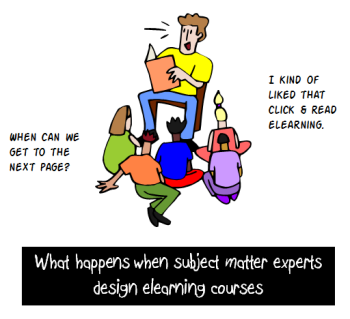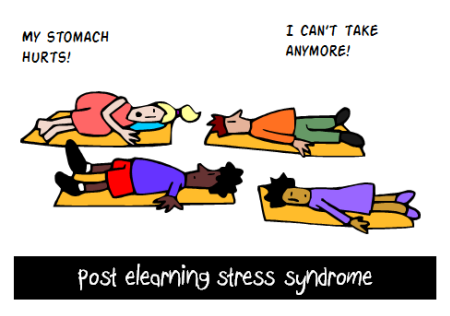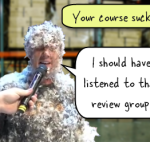Thank you for this article, and this web site. Such a wonderful resource.
How Can Your Learners Help You Build Better E-Learning?
February 11th, 2014
One of the best ways to build good elearning is to get close to those who are going to take the courses. This is because they often understand the content in a different way than the organization does.
A few years ago I worked for a large financial institution and was hired to build training for loan officers. One of my first requests was to meet with some loan officers. I wanted to get a sense of how they did their jobs and the decisions they made as it related to the course material.
I was told by the senior level management that the loan officers didn’t have time to meet with me and that it was a waste of time because the organization already knew what they needed to teach. I just needed to focus on the content and not waste time meeting with people who didn’t determine what that content was.
As can be expected, the result was a long-winded training program full of information but largely irrelevant to what the loan officers needed to do. But it was compliant with the various financial regulations, so the organizations saw it as a win. However, they missed an opportunity to craft a program more valuable to those they were training.
Understand Your Training Objectives
The truth of the matter is that often the objective of the training program really isn’t training. Often it’s to have a legal check mark on a piece of paper come December 31. In that case, instructional design is not the primary concern. Thus trying to figure out how to make the course more than an information dump can be a challenge.
It’s important to distinguish between compliance courses with no real training objectives from those where you are required to help change behaviors or improve performance. One type of course can get away with a simple information dump, but the other can’t.
Following are some tips to leverage the expertise and perspective of your learners to help develop an elearning course that meets their performance goals.
A Second Set of Eyes Always Helps
We tend to have blind spots or are a bit myopic. So it’s easy to overlook things that may be obvious to those who are less vested in what we’re doing. In that sense, it’s a good thing to have someone add eyes to the project.
When I prototype a course, I like to have someone look over it and provide feedback. It always amazes me how the second set of eyes helps. Often they’ll pick up on ways to tighten the visual design and many times offer ideas on how to approach the content from a different angle.
I may not always use the feedback, but the second set of eyes usually exposes something that forces me to think more about what I am doing.
Make time to get feedback from those who will take your courses. Ideally it’s a mix of recent and experienced staff. And don’t wait until the end. Try to pull them into the process as soon as you can. Build a prototype and have them give you feedback right away.
Only Course Developers Care About E-Learning
Most likely those who have to take the elearning courses don’t care about the courses as much as you do. Usually that’s because the elearning courses they take are largely irrelevant to their needs. Much of the training they have to complete has little to do with their performance goals and more to do with regulatory compliance. If I’m not a sexual harasser, why am I taking a course on sexual harassment? And then why is that course so long?

With all that said, there usually is a relevant angle to most of the training we create. It’s just that we need to discover it. If you want a course that is relevant to your learners, here are a few simple tips:
- Ask the learners to review the content and then frame it in a perspective that makes sense to them and works in their world. I often ask for scenarios where these issues may happen. What types of decisions do they need to make? How do they handle them? Those scenarios can find their way into your courses.
- Don’t rely solely on your subject matter experts. They may know the content, but over time they lose perspective on how they acquired it. Connect with recent learners to get their perspective. Compare what they learned in the training program to what was actually required on the job. See if there’s an opportunity to make the training better and more like the world they’ll function in.
- Recruit people who don’t know anything about the course and have them go through it. Observe what they did and how they interact with the course. If you can’t afford a formal usability testing process, that’s OK. I usually have my wife or someone in the family look over the course. I’m sure you can find someone at work who can provide some insight. One set of eyes is better than no set of eyes.
- Don’t wait until the end. Many developers wait until the course is almost complete before they test it. That doesn’t leave a lot of time to make changes. Develop a quick prototype and test that. Get some feedback and then start building. Find a few places to test and adjust. Often you’ll get valuable feedback that could change the way you want to develop the course. But if you wait until the end, it’s not going to happen.
One of the biggest questions I get is how to make the courses more engaging and relevant to the end user. A first step is to connect to the end user. Get their perspective and feedback and you’ll build more meaningful elearning courses.
What do you do to connect with the end users during your course development?
Events
- Everyday. Check out the weekly training webinars to learn more about Rise, Storyline, and instructional design.
Free E-Learning Resources
 |
 |
 |
|
Want to learn more? Check out these articles and free resources in the community. |
Here’s a great job board for e-learning, instructional design, and training jobs |
Participate in the weekly e-learning challenges to sharpen your skills |
 |
 |
 |
|
Get your free PowerPoint templates and free graphics & stock images. |
Lots of cool e-learning examples to check out and find inspiration. |
Getting Started? This e-learning 101 series and the free e-books will help. |
4 responses to “How Can Your Learners Help You Build Better E-Learning?”
Congratulations on having 1 of the most sophisticated blogs I’ve come throughout in some time! Its just incredible how much you can take away from something simply because of how visually beautiful it’s! You’ve put with each other a great blog space –great graphics, videos, layout. This is absolutely a must-see weblog!
Thank you very much for publishing this kind of article. I like your article very much. I want share my website details to you please give me some information to increase performance like as your website
I recently modified a Social 10-2 print course for my DE students and their input was invaluable. I asked the first 2 or 3 students who enrolled to mark the pages where I had made typos or connection errors. I can’t believe what I missed!
Great article!









0
comments